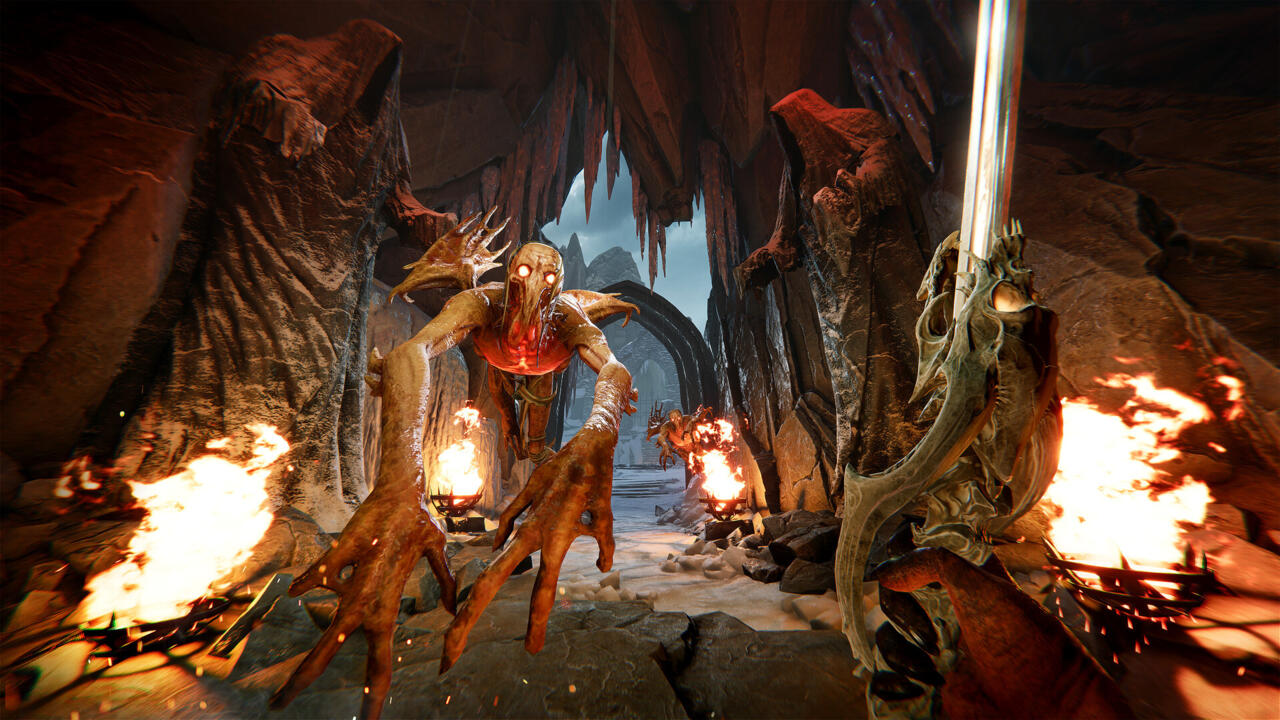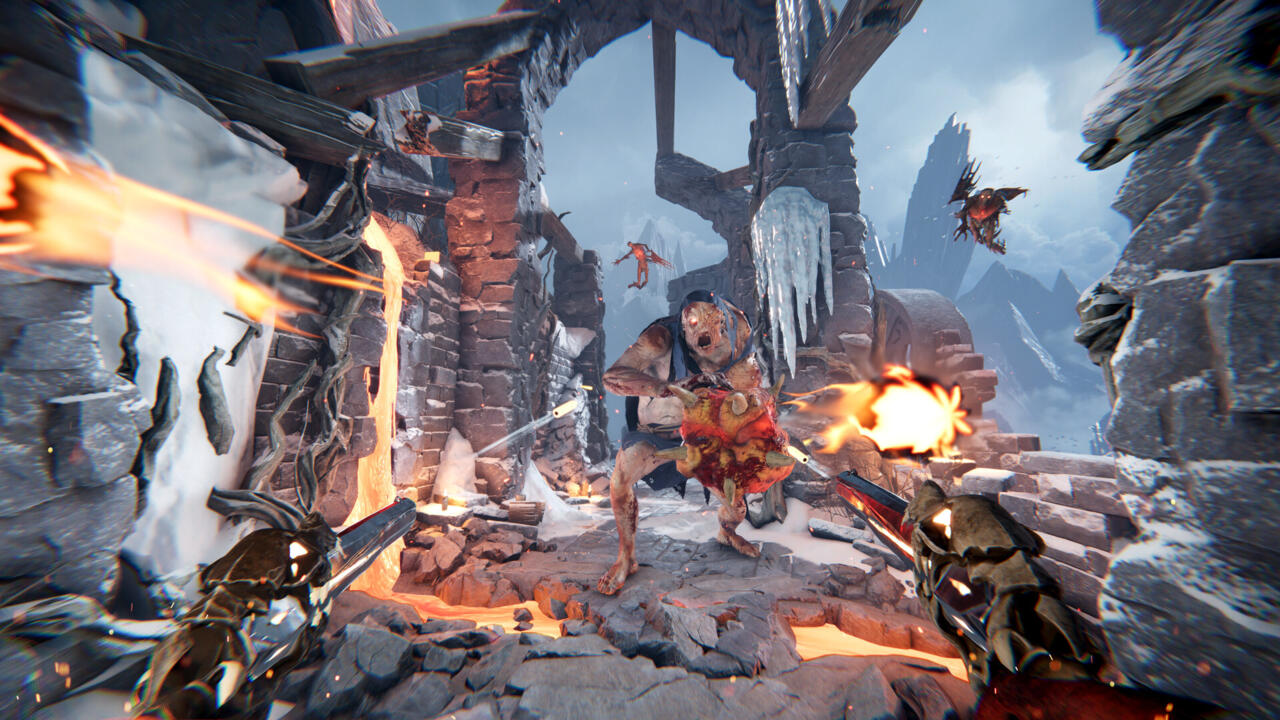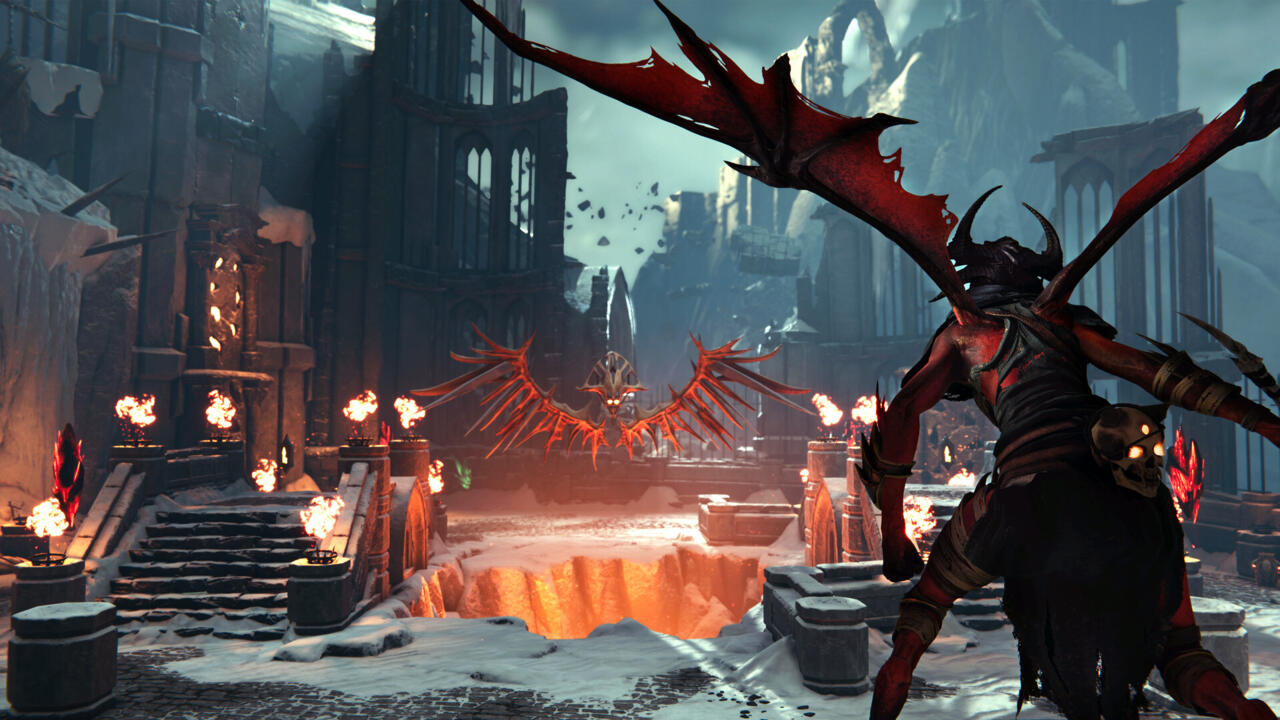Metal music ought to be synonymous with first-person shooters, considering the original Doom is perhaps the most influential FPS of all time. That game's frenetic demon-slaying was accompanied by the iconic sounds of 32-bit heavy metal riffs and high-tempo drums, but the marriage between the two never really caught on outside of shooters like Quake, Killing Floor 2, and Mick Gordon's phenomenal work on the most recent Doom games. Metal: Hellsinger isn't likely to buck that trend, but this rhythm-based FPS from Swedish developer The Outsiders puts metal front and center as the most crucial aspect of its high-octane gameplay.
At first glance, Metal: Hellsinger may look like little more than an imitation of 2016's Doom, from the general demon-killing and Hell-inspired aesthetic right down to the searing pace of its action. Doom is an obvious inspiration and apt comparison, but Metal: Hellsinger adds an extra layer of depth to its shooting by structuring all of its moving parts around music. You play as a demon who's fighting through Hell on a revenge mission, and you deal more damage by shooting enemies to the beat of a song. The more precise you are about keeping rhythm, the more your Fury multiplier will grow and the more your overall score and damage output will increase. To help you achieve this, there are pulsating icons on either side of the crosshairs that match up with the rhythm of the song. If you're on beat, you'll be graded with either a "Good" or "Perfect" attack, with the latter dealing the most damage and adding more to both your Fury and score.

Beyond the nitty-gritty of its mechanics, however, killing demons in time to a song's rhythm is just incredibly satisfying. There's an added oomph to the sound of your weapons when you're on beat, and increasing your Fury has a direct impact on the music, too. As the multiplier escalates from 1x up to 16x, the music builds until eventually reaching a rip-roaring crescendo as the vocals kick in and the song's full arrangement is unleashed, battering your eardrums with the kind of guttural vocals that perfectly fit the game's demonic aesthetic.
It feels like you're the driving force propelling the song forward with each kill, and reaching this point and maintaining it requires you to fall into a zen-like flow where shooting to the beat almost becomes second nature. BPM: Bullets Per Minute scratched a similar itch, but Metal: Hellsinger refines the concept and is unlike anything I've ever played, especially when you compare it to the moment-to-moment gameplay of traditional first-person shooters. Instead of shooting at every moment possible, you have to do so when it makes sense musically. Even dashing and reloading in time with the beat builds Fury, as do the Doom-style executions that reward you with health. You're essentially rewiring your brain, but it's so intuitive and responsive that when it all clicks, there are few shooters quite as gratifying.
It helps, of course, that the soundtrack absolutely shreds. All of the music in Metal: Hellsinger is composed by the duo of Elvira Björkman and Niklas Hjertberg of Two Feathers. Björkman and Hjertberg play bass and rhythm guitar on each track, while Dino Medanhodzic handles lead guitar and Adam Janzi (from the band VOLA) is behind the drums. There's also an all-star selection of metal vocalists lending their talents to Metal: Hellsinger, including Randy Blythe from Lamb of God, Alissa White-Gluz from Arch Enemy, Matt Heafy from Trivium, Serj Tankian from System of a Down, Mikael Stanne from Dark Tranquility, and my personal favorite, Tatiana Shmayluk from Jinjer, among others. Getting to hear new material from some of the best vocalists in the genre is a treat, especially when it's so intertwined with the gameplay.

Each level has an original song associated with it, and they run the gamut of different styles and subgenres of metal. This adds variety but also feels like a nod to the various vocalists involved. For instance, Burial at Night--the song featuring Tatiana Shmayluk--has some prominent bass-slapping that's reminiscent of many Jinjer songs, while the Alissa White-Gluz track features harmonized guitars (and the catchiest chorus on the soundtrack). All of the songs are excellent, though, to the point where I would happily listen to the full soundtrack outside of the game.
The songs are somewhat limited by the game's conceit, so don't expect any thrash metal or tempo and time signature changes from the drums. Altering the consistent beat that runs through each track would make Metal: Hellsinger nigh on impossible to play. Your arsenal of weapons does change how often you can fire, though, lending each firearm its own sort of cadence. The Persephone shotgun, for instance, has a slower rate of fire, so it can only shoot on every other beat, while The Hounds dual revolvers can fire on every single beat until you need to reload. This makes each weapon feel like an instrument in and of itself, and the sounds they make--whether it's the rewarding crunch that accompanies each perfectly timed shot or the musicality of every weapon's reload--only reinforces this sentiment. Every aspect of Metal: Hellsinger makes you feel connected to the music.
When you're in rhythm, you'll notice pyro bursting out from the floor like you're in the middle of a Rammstein concert. And some of the enemies pulsate with an orange glow along with the beat. These are nice touches that make the game world feel more reactive to your performance, but the level design itself is rather formulaic. Each level consists of moving from one combat arena to the next until you eventually face off against a boss. Maybe deviating from this formula would've proven problematic, considering the rhythmic nature of the whole game, but it does make your trek through the bowels of hell feel rather samey. The same can be said of its boss fights, too, as each one pits you against the same skeletal bat-like creature, with the only visual fluctuations occurring on its head. Each one peppers you with projectiles you need to evade before summoning a wave of enemies, and while this is exciting the first time, it doesn't take long before each boss fight is little more than a bland footnote at the end of every level.

I completed Metal: Hellsinger in four hours, so at least these issues aren't compounded by the concept being stretched too thin. Despite its short duration, however, the scoring system and the inclusion of leaderboards add a lot of replayability, especially since the game functions more like a dedicated rhythm game than a shooter with musical elements tacked on. It's easy to fall into a rewarding loop built around improving your score and moving up the leaderboards that's not too dissimilar from playing something like Guitar Hero. There's also an interesting score breakdown at the end of each level that shows different stats, like the percentage of the level you spent at 16x Fury, the number of kills you achieved on the beat, or the longest hit streak you mustered. This shows the areas you can potentially improve upon next time around, but also factors into the game's Torments, Sigils, and Boons.
There's also a story that's told via static cutscenes in between levels. It's a campy tale of revenge featuring warring skeletons, fallen angels, and the southern drawl of Troy Baker's narration. The latter gives the narrative some life, and the illustrations used throughout make it feel like you're traveling through a Dio album cover. It's neither bad nor good, it just kind of exists to add some meaning to all of the wanton demon-slaying.
You know that rare moment in video games where your actions unintentionally line up with the music you're listening to, whether it's the game's soundtrack or your own? Metal: Hellsinger bottles up that magic feeling and repeats it over and over again without the satisfaction ever fading. The interplay between its chuggy metal soundtrack and high-octane gameplay is phenomenal and quite unlike anything else I've ever played. It stumbles at times, and these issues hold it back from reaching Rob Halford-esque highs, but its execution of an idea, and the way this transforms the moment-to-moment action of a shooter into a rhythmic slaughter, props up any of its faults. If Metal: Hellsinger is a metal album come to life, then I can't wait for this band's sophomore effort.